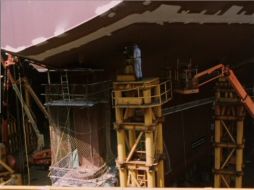|
Newest Reviews:
New Movies -
The Tunnel
V/H/S
The Tall Man
Mama Africa
Detention
Brake
Ted
Tomboy
Brownian Movement
Last Ride
[Rec]³: Genesis
Hara-Kiri: Death of a Samurai
Indie Game: The Movie
Abraham Lincoln: Vampire Hunter
Old Movies -
Touki Bouki: The Journey of the Hyena
Drums Along the Mohawk
The Chase
The Heiress
Show
People
The Strange Affair of Uncle Harry
Pitfall
Driftwood
Miracle Mile
The Great Flamarion
Dark Habits
Archives -
Recap: 2000,
2001, 2002,
2003, 2004
, 2005, 2006,
2007 , 2008
, 2009 ,
2010 , 2011 ,
2012
All reviews alphabetically
All reviews by star rating
All reviews by release year
Masterpieces
Screening Log
Links
FAQ
E-mail me
HOME
| |
At Sea (Peter Hutton, 2007)
 Were
it not for creator Peter Hutton’s decision to film without sound, his 2007
experimental documentary At Sea might
be considered a relatively straightforward work. Divided into three sections,
this unique film shows the construction, the use, and the dismantling of two
massive freight ships. Over the course of the film's one-hour run time, we see a
structural cycle of birth, life, and death, although the ships featured in the
three sections of the movie are not the same (for obvious logistical reasons).
With no narration, and no sound at all, Hutton’s film forces attention onto the
images that he’s captured, inevitably helping viewers to appreciate the familiar
sights that he has been captured a new manner. As people familiar with these
gigantic vessels, we are used to processing images of machines at the same time
that we hear the cacophonous noises of industry. To have that din stripped away,
and to abstract the work being done through compositional choice, is to
reconfigure the rhythms and forms of industry into something new. We might have
seen the sights that Hutton chooses to film before, but we have not seen them as
they are presented here. Men riding in a freight elevator become participants in
a geometrical sculpture. A massive ship deck that is hoisted by an equally
massive crane above an Asian seaside port town becomes a marvelous defiance of
the laws of gravity. When combined with Hutton’s camerawork, which always
remains at an extreme distance, the silence works to emphasize the scale of what
we see. Workers scurry like ants around the frame, dwarfed by the behemoths that
they have made. The slow pace of Hutton's edits gives the film's unfolding a
lumbering quality that befits its gargantuan subjects. Were
it not for creator Peter Hutton’s decision to film without sound, his 2007
experimental documentary At Sea might
be considered a relatively straightforward work. Divided into three sections,
this unique film shows the construction, the use, and the dismantling of two
massive freight ships. Over the course of the film's one-hour run time, we see a
structural cycle of birth, life, and death, although the ships featured in the
three sections of the movie are not the same (for obvious logistical reasons).
With no narration, and no sound at all, Hutton’s film forces attention onto the
images that he’s captured, inevitably helping viewers to appreciate the familiar
sights that he has been captured a new manner. As people familiar with these
gigantic vessels, we are used to processing images of machines at the same time
that we hear the cacophonous noises of industry. To have that din stripped away,
and to abstract the work being done through compositional choice, is to
reconfigure the rhythms and forms of industry into something new. We might have
seen the sights that Hutton chooses to film before, but we have not seen them as
they are presented here. Men riding in a freight elevator become participants in
a geometrical sculpture. A massive ship deck that is hoisted by an equally
massive crane above an Asian seaside port town becomes a marvelous defiance of
the laws of gravity. When combined with Hutton’s camerawork, which always
remains at an extreme distance, the silence works to emphasize the scale of what
we see. Workers scurry like ants around the frame, dwarfed by the behemoths that
they have made. The slow pace of Hutton's edits gives the film's unfolding a
lumbering quality that befits its gargantuan subjects.
Many of Hutton’s images are breathtakingly composed, especially in the
mid-section of At Sea, where nature
itself becomes the film’s auteur, and we are reminded of the visual marvels of
rain, sleet, clouds, and the ocean itself. The Toledo Spirit and the Prasad, as
the imposing ships at the center of the film are named, serve at once as
landscapes, objects, spectacles, and characters. The narrative arc here, which
takes us across the ship’s life span, is so slim as to be better described as a
thematic one. The decision to emphasize image through the use of silence only
increases the power of what we see. Unlike most silent films, the silence here
becomes a most striking aesthetic aspect, and transforms the work's meaning.
At Sea is a true epic that only
stumbles in its final act, as Hutton shifts his focus from the freighters. As
the image turns black and white, the director repositions the subject of the
film to the scrap-hunting humans who salvage metal from the wasted hull of the
Prasad on an anonymous beach. Hutton allows people get closer to the camera, and
even directly look into its gaze, breaking the impressive, totemic spell created
by the ships. The recognizably human presence diminishes the power of what has
come before, somewhat, even as it turns the creators of these impressive beasts
into the lowly scavengers of their corpses.
66
Jeremy Heilman
08.03.10
|